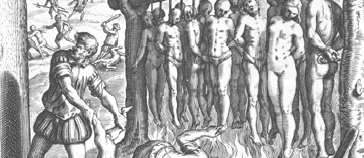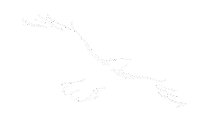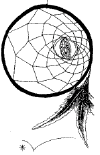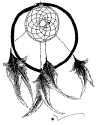|
Poverty and Despair: The Failed Policies & Human
Rights Violations directed against Native Americans
Origins of Violence
-
2
Recognizing a Native American Holocaust
Prologue
Before Columbus
Pestilence and Genocide
Sex, Race and Holy War
Epilogue
Excerpt from The Destruction of the Indies
by Las Casas
Examining the Reputation of
Christopher Columbus
Christopher Columbus, Marrano and Mariner
Christopher Columbus Jewish and New Christian
Elements
Christopher Columbus and the Indians
Columbus My
Enemy
The Native American Discovery of Europe before
Columbus
Columbus exposed as iron-fisted tyrant who
tortured his slaves
Columbus Day -The white man’s myth and the Redman's
Holocaust
How Lincoln's Army 'Liberated' the Indians
Lincoln Targeting Civilians Is a War Crime
Massacre at Sand Creek
Wounded Knee Hearing Testimony
An Ojibwe Trail of Tears
Wisconsin Trail of Tears
Ojibwe Fishing Rights Restored in
Wisconsin Following Court Victories
Ojibwe Fishing Rights in Minnesota
Nick Hockings Spears Fish
to Remember and Honor the Old Ways
Fish and Wildlife Students Visit an Ojibwe
Wildlife Management Facility at Lac du Flambeau
To Spear or Not to Spear Is NOT the
Question
Ojibwe Creation Story
Paleo-American Origins
Myth of the Ten Lost Tribes of Israel
Tracing the Path of Violence: The Boarding School
Experience
Canadian Genocide of Indian Children by Church and
State-
2 -
3
Residential School Genocide: Why "Apology" Isn't
Enough
Canadian Prime Minister Harper Apologizes for
Residential School Abuse
Quantum Physics Leads Science Back to the Sacred Fire
Cultural Differences Can Lead to Misunderstanding
The Wallum Olum: a Pictographic History of
the Lenni Lenape, Root Tribe from which the Ojibwe arose
A Migration Legend of the Delaware Tribe
Wallum Olum: The Deluge
-
Part II
Winter Count: History Seen from a Native
American Tradition -
2 -
3
The Story of the Opposition on the Road to
Extinction: Protest Camp in Minneapolis
Who Deems What Is Sacred?
Savage Police
Brutality vs Nonviolence of the People
Mendota Sacred Sites - Affidavit of Larry
Cloud-Morgan
Cloud-Morgan, Catholic activist, buried
with his peace pipe
Larry Cloud-Morgan
and the Silo Pruning Hooks
Larry Cloud-Morgan:
Testimonies to a Great Soul
The Truth about Khazars -
2
 Maritime
Pine Pycnogenol
is
the super-antioxidant that has been tried and tested by over 30
years of research for many acute and chronic disorders. The
Ojibwe knew about it almost 500 years ago. Didn't call it
that, though. White man took credit. Maritime
Pine Pycnogenol
is
the super-antioxidant that has been tried and tested by over 30
years of research for many acute and chronic disorders. The
Ojibwe knew about it almost 500 years ago. Didn't call it
that, though. White man took credit.
Seroctin--the
natural serotonin enhancer to reduce stress and depression,
and enjoy better sleep
Plant by Nature is Organic Gardening Nature's Way
Photo
Gallery
Traditional Life of the Ojibwe
Aurora Village Yellowknife
The Making of a Man
Little Dancer in the Circle
Friends in the Circle
Grass Dancer
Shawl Dancers
Jingle Dress Dancers
Fancy Shawl Dancer
Men Traditional Dancers
Powwow:
The Good Red Road
Crater Lake Photo Gallery
Crater Lake Landscape
Flowers of Crater Lake
Birds & Animals of Crater Lake
Gold Mantled Ground Squirrel
The Rogue River
Sacred Fire of the Modoc
Harris Beach Brookings Oregon
Listen to
American Indian Radio
while you surf
 Museum-quality
willow animal effigies of the Southwest
Archaic culture, art from a 4,000 year-old tradition by Bill Ott Museum-quality
willow animal effigies of the Southwest
Archaic culture, art from a 4,000 year-old tradition by Bill Ott
Unique Cherokee Dream-Catcher
from basket-weavers' numerology by Catherine
Sundvall
Indian Tribes and Termination
Ojibwe
Encampment on the Winnipeg River by Paul Kane
Ojibwe Art and Dance
Interpreting the Ojibwe Pictographs of
North Hegman Lake, MN
Ojibwe Forestry and Resource Management
Ojibwe Homes
Ojibwe Honor Creation, the Elders and
Future Generations
Ojibwe Indian Reservations and Trust Land
Ojibwe Language
Introduction to Ojibwe Language
Introduction to Ojibwe Noun and Pronoun Grammar
Introduction to Ojibwe Numbers
and Money
Introduction to Ojibwe Verbs
and Preverbs
Introduction to Ojibwe
Verb Grammar
Introduction to Ojibwe Command and Question Grammar
FREELANG OJIBWE DICTIONARY - free downloadable Ojibwe-English &
English-Ojibwe dictionary form
Freelang.net.
Ojibwe Snowshoes and the Fur Trade
Ojibwe Sovereignty and the Casinos
Ojibwe Spirituality and Kinship
The
Question of Quantum
-
2 -
3 -
4
Family, Community, and School Impacts on
American Indian and Alaska Native Students' Success
Tracing the Path of Violence: The Boarding
School Experience
Quantum Physics Leads Science Back to the Sacred Fire
Cultural Differences Can Lead to Misunderstanding
Ojibwe Tobacco and
Pipes
Traditional Ojibwe Entertainment
Soul of the Indian:
Foreword
The Great Mystery -
2
The Family Altar -
2
Ceremonial and Symbolic Worship
-
2
Barbarism and the Moral Code
-
2
The Unwritten Scriptures
-
2
On the Borderland of Spirits
-
2
Charles Alexander Eastman

|
|
The Native
American Discovery of Europe before Columbus
Our stories of the Seventh Prophecy tell us that the Ojibwe
people once lived along the Atlantic Ocean in what is now New Foundland,
Nova Scotia, Maine and as far south as Virginia. Many histories commonly
tell of the visits of men of the light-skinned race to this area as early as
1000 AD. But long before this it was Native Americans who had visited
Europe, Ireland as far as the North Sea. In around 1470 Native Americans,
at least a man and a woman, had landed
in Galway Bay, Ireland and Christopher Columbus spoke with them. This is the
knowledge that made Columbus so certain that he could sail westward across
the Atlantic and find another land. He thought it would be the Orient and
India. He later learned many other sources to support this concrete evidence
but the firstperson testimony of these Native American explorers was "hard
evidence" that anchored all of his research.
The books that Columbus read also referred to "Indians" who
had landed in Germany with merchandise. In his copy of Aeneas' Historia
rerum he wrote:
If it was a great distance [from India to Germany] the
vessels could not pass without ill fortune; but this proves that it is near
at hand.
He also wrote in the margins of his copy of Historia,
People from Katayo came towards the east. We saw many notable
things, and specifically in Galway, Ireland, a man and his wife.
We can see from his notations that Columbus learned of the
relatively short distance to exotic, unknown lands westward across the
Atlantic. The mythical "courage" that has been assumed was actually an
assurance that was the result of his contact with Native Americans who had
survived a crossing of the Atlantic from the west. Therefore, he knew he
would survive a crossing of the Atlantic from the east to the west. He just
thought it would be China and India and was very confused when he arrived in
the New World.
In
THE AMERICAN DISCOVERY OF EUROPE,
Jack D. Forbes writes:
American history does not begin in
Europe, nor does it commence with Columbus' voyage of 1492 nor even with
the Viking explorations five centuries earlier. According to THE
AMERICAN DISCOVERY OF EUROPE America, north and south, have long been
populated by intensely adventurous and inventive people who were
themselves explorers, colonists, and developers of civilizations.
The First Americans explored and settled
the entire American hemisphere including each and every inhabitable
island, a story of epic proportions.
THE AMERICAN DISCOVERY OF EUROPE takes up
the saga of American travel and exploration in ancient times . The
primary focus of this work is to present evidence relating to American
voyages to European waters from about 9000 years ago to the fourteenth
and fifteenth centuries of our own era.
The story of Native American voyages and
adventures in the Caribbean and Atlantic, some going back perhaps
thousands of years, can be seen as part of a revolution taking place in
the very notion of what constitutes the history of the Americas. Here we
see the Original Americans as being actors in the drama of human
history, as discoverers in fact ( a title seldom heretofore reserved for
them).
Readers may be amazed at the information
about American maritime activity, with advanced sea-going cultures
extending back in time to at least 7,500 years ago in the area of
northeastern New England through Labrador (where, apparently, the first
toggle-headed harpoons were used anywhere on earth). The Atlantic
Seaboard generally, southward to Brazil, and the Caribbean region,
provide evidence of vital sea-going cultures largely unknown to modern
historians and the general public. But also the Inuit or Eskimo-related
peoples of the Greenland region provide data indicating superb maritime
accomplishments, including the circumnavigation of Greenland and
navigation in difficult polar waters, extending apparently to the North
Sea of Europe.
The arrival of Americans in Europe before
1492 suggests that a revision of American history is in order. Not only
did Columbus himself respond directly to contact with a man and a woman
whom he met in Ireland in c. 1477, after their voyage from the west, but
the evidence of other arrivals was cited by the European cosmographers
who influenced navigators seeking a sea route to the west.
The American story in Europe also
includes the very substantial numbers of Indigenous Americans who
reached that continent as captives, visitors, emissaries, and sailors
after 1492 and who have had a powerful genetic, cultural and
intellectual impact upon European developments. This part of the story
has been severely neglected by scholarship which has remained largely
unconcerned about Original American influences upon European physical
and cultural evolution.
THE AMERICAN DISCOVERY OF EUROPE will
require a reevaluation about how American history, including the history
of the Americas, is written and taught. Certainly it is an exciting
project, which opens up thousands of years of new time-depth for
historians and others to work in, breaking down the notion that only
archaeologists should deal with pre-1492 America's past. Even more, it
transforms Native Americans from mere objects which are acted upon into
actors participating not only in American history, but in world history
as well.
Here is a work that can extend the history of
my people into the pre-history of Europe, visiting there and gathering
information that one day led to the warnings of the
Seven Prophets. It is said that around 900
AD seven prophets came to my people to warn them of the times to come in
which a Light-skinned Race would come to their lands, some of them seeking
cooperation and sharing and others with a long face and sullen attitude who
would try to steal from them and dominate them. They were warned to remove
themselves from their ancestral lands to move far into unknown territory
toward the setting sun. There they would find a haven that would allow them
to maintain their culture while others who remained along the great salt
water would be invaded and overwhelmed by the Light-skinned Race. Thus
began the great migration through Great River into the Great Lakes that
would become the Great Ojibwe Sea and become well-known through the poetry of
Longfellow as Gitchie gumi, a corrupted Ojibwe name for the Great
Sweetwater, Gitchie-gami.
Jack Forbes says of his background that has
lead him to his research into
THE AMERICAN DISCOVERY OF EUROPE:
Growing up as a mixed-blood of part-Native
American ancestry, living among relatives with unique and original
opinions, exposed to very strong and independent aunts and cousins willing
to break with popular conventions, and living in the midst of Mexicans of
Indigenous origin in the countryside of El Monte, California, I was led
thereby at any early age to explore sources about ancient America, north
and south, with an openness of mind, an openness which soon brought me
into conflict with books which pretended that “American” history commenced
in Europe and that the Pilgrims and the Jamestown adventurers were the
“first Americans.” The Native Americans were consciously transformed into
enemies and aliens who were not seen as being actors in the drama of
American history except as enemy warriors or victims of a triumphant
imperialism.
All during high school and college I grappled with the Eurocentric
orientation of most history texts, until, finally, with my first book,
APACHE, NAVAHO, AND SPANIARD, I was able to approach American history from
a perspective which ignored current boundaries and which accepted the
possibility that Native Americans were legitimate actors in their own
history and not simply foil or environment for European adventurers. The
field known as “the new American Indian history” grew partly from that
beginning.
The great challenge that we face as twentieth-first century scholars is to
be able to shift history away from the practice wherein each dominant
group seeks to impose its own vision of the past, and instead to make the
story of an entire land, a whole continent, or even the entire globe the
focus of our research. This is what THE AMERICAN DISCOVERY OF EUROPE
attempts to do. It’s objective is not only to tell part of the story of
ancient America, but to open up our minds to what the very concept of
“American” really means, showing that we do live in a very old part of the
Earth, and a part which has had a significant history which we should no
longer dismiss as “prehistory” or ignore because “Indians” were only
“savages” after all.
The American hemisphere and its original peoples are the focus of this
work. I invite the reader to join me in an adventure, a discovery of what
riches are to be found when we extend our horizon beyond the intellectual
borders conceived in colonialism.
This book will be available in late 2006 or early 2007, but orders can be
sent in at any time I am told.
Comments from other reviews:
"A fascinating book that makes an important .
. . contribution to the subject of pre-Columbian contacts between American
and Europe. . . . Highly recommended."--Choice
"Provocative. . . . Turning the concept of 'discovers' on its head, Forbes
dispels a lot of common assumptions about who 'discovered' whom in the
Americas, in an extensive and fascinating exploration of early maritime
histories of the Native Americans."--Bloomsbury Review
"Forbes makes an unusual and fascinating contribution to the story of the
New and Old Worlds and the links between them, questioning in a welcome way
the truth and ideological sway of orthodox history. He leads his reader
along paths rarely, if ever, trodden, ultimately in search of a fairer
account of native America and its role in the world. This is a quest
Forbes's own ancestry and--not least--keen sense of language well equip him
to undertake. He eminently succeeds."--Gordon Brotherston, author of Image
of the New World: The American Continent Portrayed in Native Texts
"A decisive, independent, and long overdue contribution that pulls the plug
from the inflated icon the Christian West has made of the slaver Christopher
Columbus in his mistaken attempt to reach India."--Hartmut Lutz, professor
of American studies, Greifswald University, Germany
| Buy this
book |
|
University of Illinois Press |
|
Amazon.com |
|
Barnes&Noble.com - $34.95 |
White Eagle Soaring: Dream Dancer of the 7th Fire
Index of DreamCatchers However
You Spell DreamCatcher
However you've spelled Dream Catcher, these REAL Dream Catchers are
natural magic from Creator Direct (Manidoog).

Dream Catchers' links
This is a crazy world. What can be
done? Amazingly, we have been mislead. We have been taught that we can
control government by voting. The founder of the Rothschild dynasty, Mayer
Amschel Bauer, told the secret of controlling the government of a nation
over 200 years ago. He said, "Permit me to issue and control the money of
a nation and I care not who makes its laws." Get the picture? Your freedom
hinges first on the nation's banks and money system. That's why we
advocate using the
Liberty Dollar, to understand the
monetary and banking system. Freedom is connected with
Debt Elimination for each individual. Not
only does this end personal debt, it places the people first in line as
creditors to the National Debt ahead of the banks. They don't wish for you
to know this. It has to do with recognizing WHO you really are in
A New Beginning: A Practical Course in Miracles.
You CAN
take
back your power and
stop volunteering to pay taxes to the collection
agency for the BEAST. You can take back that which is yours,
always has been yours and use it to pay off your debts. And you can send
others to these pages to discover what you are discovering.
 Get
a course to promote your business online, explode your sales Get
a course to promote your business online, explode your sales
 Get
software to promote your business online in less time Get
software to promote your business online in less time
 Get
software to streamline your business and run it hands free. Get
software to streamline your business and run it hands free.
Disclaimer: The
statements on www.real-dream-catchers.com have not been evaluated by the FDA.
These dream catchers are not intended to diagnose nor treat nor cure any
disease or illness
© 2007, Allen Aslan Heart / White Eagle Soaring of the Little Shell Pembina Band, a
Treaty Tribe
of the Ojibwe Nation
|


 Over
twenty years of exhaustive research in libraries throughout Europe and the
United States, Jack D. Forbes employs a vast number of primary and
secondary sources to paint a clear picture of the diverse and complex
societies that comprised the Americas before 1492 and reveals the
surprising Native American involvements in maritime trade and exploration.
Starting with an encounter by Columbus himself with mysterious people who
had apparently been carried across the Atlantic on favorable currents,
Over
twenty years of exhaustive research in libraries throughout Europe and the
United States, Jack D. Forbes employs a vast number of primary and
secondary sources to paint a clear picture of the diverse and complex
societies that comprised the Americas before 1492 and reveals the
surprising Native American involvements in maritime trade and exploration.
Starting with an encounter by Columbus himself with mysterious people who
had apparently been carried across the Atlantic on favorable currents,






 Get
a course to promote your business online, explode your sales
Get
a course to promote your business online, explode your sales Get
software to promote your business online in less time
Get
software to promote your business online in less time Get
software to streamline your business and run it hands free.
Get
software to streamline your business and run it hands free.